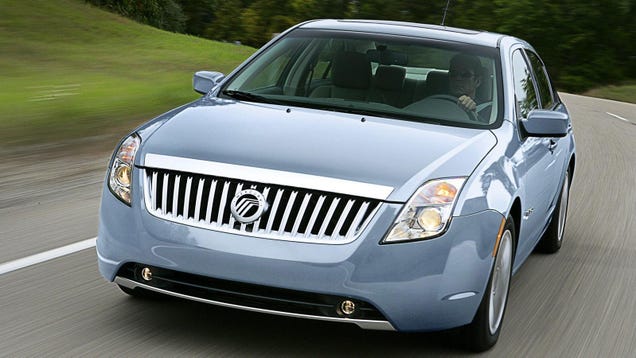We reminded you of some modern last week, but this week we’re flipping to the new craze that’s sweeping the nation — . are the new among profit-hungry car makers after buyers failed to swarm to , but check these out before you go buy an expensive that anyone else could get. This list of forgotten consists of some great cars that for whatever reason never sold in big numbers, or had platform-mates that sold in .
This list has a bit of everything, from tiny two-seaters to full-size hybridized pickups, so if you’re hankering for a hybrid, you’re in the right place. Cars with hybrid powertrains were initially introduced to the car-buying public to save gas, but many were woefully dull to drive. Thankfully modern hybrids are beginning to meet efficiency in the middle with driving pleasure; even the once-loathed Toyota Prius was injected with a shot of fun for its latest generation.

Hybrids have come a long way in a few short years, but they still tend to be more expensive than their internal combustion-powered siblings. If you’re looking for a cheap and distinctive hybrid, your search is about to be reinvigorated. 2 / 17 General Motors unleashed a gaggle of mild-hybrid models around the same time, resulting in vehicles like this GMC Sierra 1500 Hybrid.
The Sierra Hybrid eventually paired a 6.0-liter V8 with a two-mode hybrid system that gave the nearly 6000-pound truck EPA fuel economy ratings of 20 mpg across the board. The nominal fuel savings weren’t consistent or significant enough to compel buyers to buy these early hybrid trucks, but they make for a fun discussion piece.
GM sold 200 Sierra Hybrids in California only. 3 / 17 The Lincoln MKZ Hybrid actually lasted for two generations, but I want to focus on the model’s final iteration. The MKZ hybrid provided buyers with a stylish, relatively luxurious, and efficient mid-size hybrid, but it was gutless and pricey.
They might not have been the best value propositions when new, but they have become very affordable on the used market. 4 / 17 Volkswagen’s own TDI effectively nullified the hybrid, since the diesel offered comparable fuel economy estimates at a lower price. The Jetta Hybrid was unique in that it had a turbocharged 1.
4-liter gas engine and electric power, so it was only slower than the hot rod Jetta GLI while still providing reasonable fuel economy. Considering how the Volkswagen diesel situation played out, I bet VW wishes the hybrid had sold better. 5 / 17 The Honda CR-Z was a bit of a misfit.
It was a tiny little two-door, two-seat hybridized hatchback that was reminiscent of Honda’s legendary CRX but arrived with a different mission than that small sporty icon. It got good gas mileage, but not good enough to justify its compromised use case as a strict two-seater. 6 / 17 Honestly, I didn’t even know Nissan ever offered the Rogue as a hybrid, so it definitely belongs on this list.
Front-drive models were rated at 34 mpg combined, while all-wheel-drive models were rated at 33. It was actually slightly cheaper than the Rav4 hybrid, so it’s surprising that it didn’t gain more traction among buyers. 7 / 17 The ActiveHybrid days were simpler times.
The world’s first Sports Activity Coupe got a hybrid powertrain that made it too expensive and didn’t provide much along the lines of fuel savings. It cost almost as much as the X6M, and though it mated an electric motor to a twin-turbocharged 4.0-liter V8, it was slower than the non-hybrid V8 X6.
It was EPA-rated at 17 mpg city and 19 mpg highway, so it was not a big hit with those hoping for more efficiency. 8 / 17 The Lexus LC is a gorgeous grand tourer, so it’s no surprise that the V8 powertrain proved more popular than the hybridized V6 option among buyers. The powertrain was unique among Toyota’s other hybrids, and actually provided good acceleration numbers, reaching 60 mph in under 5 seconds, but it just never sold like the V8.
9 / 17 The first-generation Hyundai Sonata Hybrid and its sibling the Kia Optima Hybrid caused a stir when they were first introduced but quickly faded into the background. The Sonata Hybrid had these intricate tail lights that looked like a rosebud, though, that will remain in my heart for as long as I live, I fear. Its front-end styling differed from the ICE car in a way that was displeasing to most, but, of course, I was a fan.
10 / 17 For being an outdoorsy and socially conscious brand, Subaru has notably lacked consistent hybrids. The hybrid XV Crosstrek was only offered for a few years, but it offered the best colors at the time, including lime green and a great turquoise blue. It was heavier and slower than the ICE XV Crosstrek, and, of course, more expensive, but it did offer somewhat better fuel economy.
11 / 17 The Mercury Milan was the brand’s version of the Ford Fusion, but slightly elevated. I have always loved the styling of Mercury’s final few models, and this is no exception. The Milan Hybrid looked striking, but didn’t offer buyers much else beyond the cheaper Ford Fusion Hybrid, and, of course the Lincoln MKZ Hybrid shared this platform and powertrain too for those who wanted true luxury.
Poor sweet Mercury went away after this fuel-efficient looker, but it’s a great way to stand out from a crowd. 12 / 17 Another forgotten hybrid from a now-dead brand, the Saturn Aura shared a platform with the Chevrolet Malibu Hybrid, and offered similarly mild improvements in efficiency over the ICE cars. It was the most affordable hybrid car when it debuted, though, with the mild hybrid powertrain proving cost-effective, if not actually effective at saving much fuel.
13 / 17 You would be forgiven if you forgot that the Acura ILX ever existed in the first place, let alone in hybrid form. It was Acura’s dull attempt at gussying up a Civic Hybrid and didn’t steal many hearts. It used the Civic Hybrid’s powertrain with a slightly more responsive throttle to make you think it was more powerful, but it wasn’t.
Fuel economy was good though, coming in at nearly 40 mpg combined. 14 / 17 The Toyota Crown has flown under the radar since going on sale in the U.S.
last year, but that doesn’t mean it’s a bad car. There aren’t many on the used market yet, but if you can find one there and save a few grand over buying one new then it’s likely to run forever and provide you with decades of trouble-free, efficient, and luxurious motoring. 15 / 17 The second-generation Honda Insight set its sights on the massively popular Toyota Prius, but never stuck in the same way as the Prius or even as the original wacky Insight.
The first Insight looked like a spaceship on wheels and took daring chances with bright colors and covered rear wheels for maximum aerodynamic efficiency. The second-generation Insight was more conventional and consequently more boring, too. The third-generation Insight continued to be boring, but they’re more common than the second-gen cars.
These Insights sell for around $10,000 used and are pretty good buys. 16 / 17 The A3 e-tron was the only way to get an Audi A3 hatchback in the U.S.
for its second generation, but that wasn’t enough to make this handsome little hybrid a hit. It was a plug-in hybrid that was rated for 16 miles of electric-only driving, and paired with a turbocharged I4 and a six-speed automatic transmission. It was a great little plug-in that you never saw many of, and that continues to be the case today.
17 / 17.



















